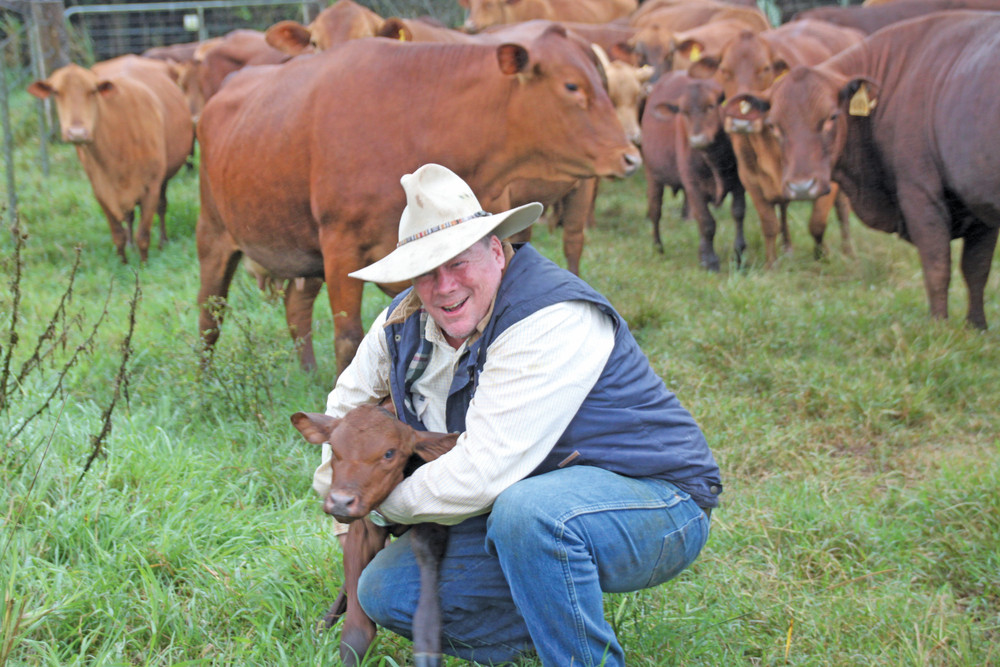On The Land
15 July, 2022
Pinnacle Pocket Senepols suit northern conditions
PETER Spies established the first registered Senepol stud north of Rockhampton and the only registered Senepol stud in Far North Queensland in 2006 and plans to open his operation to the public for the first time in this year's Better Beef Open Day.

Mr Spies said Pinnacle Pocket Senepols and Composites had enjoyed considerable success on the show circuit since 2009, including Supreme Champion Beef exhibit Cairns Show 2010 and Grand Champion bull at the Atherton, Malanda and Cairns Shows in 2011.
The stud prioritises polledness, a tidy sheath, scrotal circumference, a slick coat, fertility, temperament and structural correctness when selecting the and replacement heifers for retention in the herd.
“When setting up my stud, I chose two breeds that suited this area – Senepol and Droughtmaster and aimed to produce very functional, well-muscled bulls with a large scrotal circumference that were ready to go to work and cover their female herd,” Mr Spies said.
With its sleek red coat and naturally polled head, the Senepol is still relatively new to Australia, but is used extensively in Bazil, South Africa and the southern United States, and has been used by Australian Agricultural Company in their composite breeding program since 1996 to produce their signature “1824” retail beef brand.
“Their ability to marble from an early age and their beef tenderness is ranked alongside the Angus and Shorthorn,” Mr Spies said.
“I read an article about a mob of milk-tooth 14- 17 month old heifers that were fed for 72 days, averaged a carcase weight of 250kg and an Ausmeat marbling score of 1.3 during chiller assessment.
“I don't finish my bulls on any grains or silage, as I believe cattle need to thrive and grow in the environment they are destined to work in.
Graziers don't want a fat, lazy bull, that takes time to be let down.
“Ideally, a bull should have a head like an aristocrat, a back like a billiard table and a butt like a Dutch lady, but the biggest northern profit driver is still fertility, so they also need early scrotal development to produce early-breeding daughters.
“The stud herd is run on high rainfall country at Glen Allyn, east of Malanda on the North Johnstone River.
Ticks and buffalo flies are a constant challenge here, so we apply strong selection pressure on our breeders for fertility and insect resistance.
“We follow best practice commercial husbandry, including early weaning, controlled mating and pregnancy testing, ensuring our cows produce a calf every year, to maintain our annual branding rate of 90 per cent plus.”
Senepols have been a fixed breed since the 1900s. They were developed from crossing a native Bos Taurus breed from Senegal, North-West Africa with the English Red Poll on the island of St Croix in the Caribbean.
They combine traits of heat tolerance and the ability to thrive on poor quality pasture with carcase quality, high fertility, feed efficiency, good temperament and the maternal and milking ability of the Red Poll.
“To date, Senepols are the only breed available in Australia that are carriers of the slick coat gene, identified by Dr Tim Olsen of the United States,” Mr Spies said.
“Smooth-coated animals are known to carry less tick burden in tick country, further improving the breeds' naturally high level of tick and buffalo fly resistance.”
An agricultural consultant in soil science and agronomy, Mr Spies uses a combination of strategies to grow his Setaria, Brachiaria, Glycine and Shaw creeping Vigna legume pastures, including applied biology and good soil bacteria and incorporating legumes and soil improvers for high weight gains.
“I use lime to correct the PH and P-solubilizing bacteria, nitrogen fixing bacteria and Endophytic Trichoderma to balance the soil's high iron and PBI (Phosphorous buffer index) to improve the grass's growth and vigour, root development and disease resistance,” he said.
“I apply molasses and some catalytic micronutrients such as silica, molybdenum and zinc to stimulate the soil biology and my summer grasses with ryegrass, chicory plantain and white and shaftall clover for winter bull feed.
“That is our Pinnacle Pocket difference – our bulls are paddock-raised and sold out of the paddock to keep the cost down for buyers.
“Southern Senepol seed-stock operations can't replicate our northern conditions to select for the tick, fly, nutrition, heat and humidity and southern imports struggle to adapt to our conditions.”
Previously employed by Queensland DPI and DNRM in land management for seven years, Mr Spies now works for Thomas Elder Consulting, a collaboration between Elders and leading Australian universities, delivering a data-driven agronomic and livestock production service to farmers.
“Our stud and herd bulls are available for inspection on-farm and are sold with fertility guarantees based on a vet-performed Bull Breeding Soundness Evaluation,” he said.
“We are a Pestivirus-free tested herd and our cattle are a pleasure to work with. Come for a look next month,” Mr Spies said.
The Better Beef Open Day will be held on Sunday 14 August.



